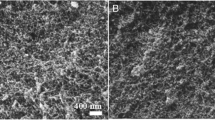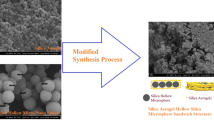Abstract
The development of efficient adsorbents is significant for the miniaturization and cost reduction of water purifying facility. In our previous study, a new kind of silica aerogel fibers (SAFs) with hierarchical structure and hollow structure were developed, which shows outstanding mass transport property and adsorption performance. Herein, we further control and study the hierarchical structure and hollow structure of silica aerogel fibers by changing the sulfuric acid concentration of ageing bath and spinning speed. For removing methylene blue, A0W120 SAFs sample, with DI water as ageing bath and a winding speed of 120 mm/s, presents the best mass transport property and adsorption performance, as they possess larger pore sizes in the outer layer, thinner fiber wall and higher degree of hollowness. The removal rates of methylene blue by A0W120 SAFs sample is up to 91.6% and 98.2% in 2 and 5 min, respectively, which are at least 30% higher than other comparable commercial adsorbents, while the adsorption capacity of methylene blue reaches up to 139.1 mg/g.
Similar content being viewed by others
References
Moiseenko T I, Morgunov B A, Gashkina N A, et al. Ecosystem and human health assessment in relation to aquatic environment pollution by heavy metals: case study of the Murmansk region, northwest of the Kola Peninsula, Russia. Environ Res Lett, 2018, 13: 065005
Ferriño P C E, Cárdenas L G C, González-Santiago O. Perception of air and water pollution and its association with cancer risk perception in a region with high cancer mortality in mexico. An exploratory study. Revista Internacional de Contaminación Ambiental, 2018, 34: 347–353
Naghdi M, Taheran M, Brar S K, et al. Removal of pharmaceutical compounds in water and wastewater using fungal oxidoreductase enzymes. Environ Pollut, 2018, 234: 190–213
Ahmed M B, Zhou J L, Ngo H H, et al. Progress in the biological and chemical treatment technologies for emerging contaminant removal from wastewater: A critical review. J Hazard Mater, 2017, 323: 274–298
Kıdak R, Doğan Ş. Medium-high frequency ultrasound and ozone based advanced oxidation for amoxicillin removal in water. Ultrasons SonoChem, 2018, 40: 131–139
Nidheesh P V, Zhou M, Oturan M A. An overview on the removal of synthetic dyes from water by electrochemical advanced oxidation processes. Chemosphere, 2018, 197: 210–227
Abdel-Karim A, Leaper S, Alberto M, et al. High flux and fouling resistant flat sheet polyethersulfone membranes incorporated with graphene oxide for ultrafiltration applications. Chem Eng J, 2018, 334: 789–799
Li J, Wang X, Zhao G, et al. Metal-organic framework-based materials: Superior adsorbents for the capture of toxic and radioactive metal ions. Chem Soc Rev, 2018, 47: 2322–2356
Bourgin M, Beck B, Boehler M, et al. Evaluation of a full-scale wastewater treatment plant upgraded with ozonation and biological post-treatments: Abatement of micropollutants, formation of transformation products and oxidation by-products. Water Res, 2018, 129: 486–498
Lima E C. Removal of emerging contaminants from the environment by adsorption. Ecotoxicol Environ Safety, 2018, 150: 1–17
Yang Y, Huang Q, Niu L, et al. Waterproof, ultrahigh areal-capacitance, wearable supercapacitor fabrics. Adv Mater, 2017, 29: 1606679
Woltornist S J, Varghese D, Massucci D, et al. Controlled 3D assembly of graphene sheets to build conductive, chemically selective and shape-responsive materials. Adv Mater, 2017, 29: 1604947
Mino Y, Sakai S, Matsuyama H. Simulations of particulate flow passing through membrane pore under dead-end and constant-pressure filtration condition. Chem Eng Sci, 2018, 190: 68–76
Hwang K J, Lo H P, Cheng T W, et al. Separation of protein from suspended particles using submerged membrane filtration. J Membrane Sci, 2010, 362: 427–433
Rafatullah M, Sulaiman O, Hashim R, et al. Adsorption of methylene blue on low-cost adsorbents: A review. J Hazard Mater, 2010, 177: 70–80
Zhuang X, Wan Y, Feng C, et al. Highly efficient adsorption of bulky dye molecules in wastewater on ordered mesoporous carbons. Chem Mater, 2009, 21: 706–716
Huang S H, Chen D H. Rapid removal of heavy metal cations and anions from aqueous solutions by an amino-functionalized magnetic nano-adsorbent. J Hazard Mater, 2009, 163: 174–179
Mousavi S, Deuber F, Petrozzi S, et al. Efficient dye adsorption by highly porous nanofiber aerogels. Colloids Surfs A-Physicochem Eng Aspects, 2018, 547: 117–125
Li C, Ren Y, Gou J, et al. Facile synthesis of mesostructured ZSM-5 zeolite with enhanced mass transport and catalytic performances. Appl Surf Sci, 2017, 392: 785–794
Saad N, Al-Mawla M, Moubarak E, et al. Surface-functionalized silica aerogels and alcogels for methylene blue adsorption. RSC Adv, 2015, 5: 6111–6122
Pan Y, Zhang L, Li Z, et al. Hierarchical porous membrane via electrospinning PIM-1 for micropollutants removal. Appl Surf Sci, 2018, 443: 441–451
Bao Y, Kang Q L, Ma J Z, et al. Monodisperse hollow TiO2 spheres for thermal insulation materials: Template-free synthesis, characterization and properties. Ceramics Int, 2017, 43: 8596–8602
Zang Z, Wen M, Chen W, et al. Strong yellow emission of ZnO hollow nanospheres fabricated using polystyrene spheres as templates. Mater Des, 2015, 84: 418–421
Langford J F, Schure M R, Yao Y, et al. Effects of pore structure and molecular size on diffusion in chromatographic adsorbents. J Chromatography A, 2006, 1126: 95–106
Chen F, Mourhatch R, Tsotsis T T, et al. Pore network model of transport and separation of binary gas mixtures in nanoporous membranes. J Membrane Sci, 2008, 315: 48–57
Yuan Z Y, Su B L. Insights into hierarchically meso-macroporous structured materials. J Mater Chem, 2006, 16: 663–677
Rooke J C, Barakat T, Finol M F, et al. Influence of hierarchically porous niobium doped TiO2 supports in the total catalytic oxidation of model VOCs over noble metal nanoparticles. Appl Catal B-Environ, 2013, 142–143: 149–160
Meng S, Zhang J, Chen W, et al. Construction of continuous hollow silica aerogel fibers with hierarchical pores and excellent adsorption performance. Microporous Mesoporous Mater, 2019, 273: 294–296
Groen J C, Peffer L A A, Pérez-Ramırez J. Pore size determination in modified micro-and mesoporous materials. Pitfalls and limitations in gas adsorption data analysis. Microporous Mesoporous Mater, 2003, 60: 1–17
Author information
Authors and Affiliations
Corresponding author
Additional information
Supporting Information
The supporting information is available online at tech.scichina.com and link.springer.com. The supporting materials are published as submitted, without typesetting or editing. The responsibility for scientific accuracy and content remains entirely with the authors.
Electronic supplementary material
Rights and permissions
About this article
Cite this article
Meng, S., Zhang, J., Xu, W. et al. Structural control of silica aerogel fibers for methylene blue removal. Sci. China Technol. Sci. 62, 958–964 (2019). https://doi.org/10.1007/s11431-018-9389-7
Received:
Revised:
Accepted:
Published:
Issue Date:
DOI: https://doi.org/10.1007/s11431-018-9389-7




